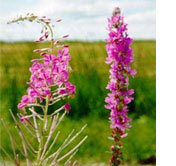Invasive Plants
An invasive plant is a non-native plant that adapts quickly and thrives in new environments. These characteristics of adaptability, mass seed production, and rapid growth allows the invasive plant to choke out native and crop plants by winning the battle for space, water and nutrients. As invasive plants spread and take over an area, they can upset the balance of water and nutrient cycling, soil building and carbon storage as well as reduce wildlife habitat and species diversity. Identification is the first step towards controlling invasive weeds.
Integrated Pest Management for Invasive Plants Must Include;
- Cultural
- Manual
- Mechanical
- Biological Controls
Most Unwanted : Found in the Carrot River Watershed
 |
Common Tansy—native to Europe, it was introduced to North America in the early 1600s for medicinal and horticultural purposes. It is widespread across Western Canada in pastures, roadsides, riparian areas, and native prairies. It has fern-like leaves and flowers that look like yellow buttons at the top of the plant. Common tansy can quickly take over a landscape, and the seeds remain viable in the soil for up to 25 years. |
 |
Scentless Chamomile— introduced to Canada from Europe in the 1930s, it has spread throughout the prairies. A single plant growing without competition may cover over one square metre. Scentless Chamomile has finely divided leaves and several flowers on each flowering stem, which differentiates it from ox-eyed daisy which has notched leaves and one flower per flowering stem. However, ox-eyed daisy is also an invasive plant species. |
Invasive plant species have the ability to choke out all other plants resulting in economic and ecological losses.
 Identification is the first step in any invasive pest management plan. Know what weeds you have, and what weeds to be on the lookout for. Use plant identification guides, local resources such as crop advisors, or other agencies to assist you if you are unsure. It is easy to become confused when plants can be so similar. An example of this is fireweed (on your left as you face the screen) and purple loosestrife (on your right as you face the screen). Fireweed is a native plant, but purple loosestrife is a non-native, invasive plant. The majority of purple loosestrife infestations are a result of garden escapes, and this weed is particularly of concern in wetlands and riparian areas. Once established it is extremely difficult to eradicate, because no herbicides are approved for control of purple loosestrife in or near waterways and this plant can regrow from even small pieces of root tissue left in the soil.
Identification is the first step in any invasive pest management plan. Know what weeds you have, and what weeds to be on the lookout for. Use plant identification guides, local resources such as crop advisors, or other agencies to assist you if you are unsure. It is easy to become confused when plants can be so similar. An example of this is fireweed (on your left as you face the screen) and purple loosestrife (on your right as you face the screen). Fireweed is a native plant, but purple loosestrife is a non-native, invasive plant. The majority of purple loosestrife infestations are a result of garden escapes, and this weed is particularly of concern in wetlands and riparian areas. Once established it is extremely difficult to eradicate, because no herbicides are approved for control of purple loosestrife in or near waterways and this plant can regrow from even small pieces of root tissue left in the soil.
Photo credit—Manitoba Purple Loosestrife Project
Did you know?
- Common tansy seeds are able to germinate for up to 25 years
- A single Scentless Chamomile plant can produce over a million seeds
Invasive Plant Management and Control Programs are available to Rural Municipalities in Saskatchewan through Growing Forward 2, and are administered by Saskatchewan Association of Rural Municipalities (SARM). The CRVWA recognizes the importance of identifying and controlling invasive plant species within our watershed to maintain biodiversity, protect wildlife habitat, and prevent economic loss. Our staff are available to assist in plant identification, access to technical support, and to assist with weed management planning.
We have invasive weed identification guides and information available to the public at our office.
